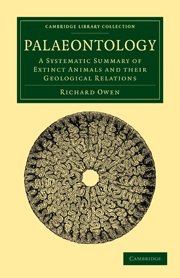-
Select format
-
- Publisher:
- Cambridge University Press
- Publication date:
- June 2011
- July 2009
- ISBN:
- 9780511693083
- 9781108001335
- Dimensions:
- Weight & Pages:
- Dimensions:
- (216 x 140 mm)
- Weight & Pages:
- 0.56kg, 444 Pages
You may already have access via personal or institutional login
Book description
Richard Owen (1804–1892) was a contemporary of Darwin, and like him, attended the University of Edinburgh medical school but left without completing his training. His career as an outstanding palaeontologist began when he was cataloguing the Hunterian Collection of human and animal anatomical specimens which had passed to the Royal College of Surgeons in London. His public lectures on anatomy were attended by Darwin, and he was entrusted with the classification and description of the fossil vertebrates sent back by Darwin from the Beagle voyage. He was responsible for coining many of the terms now used in anatomy and evolutionary biology, including the word 'dinosaur'. Palaeontology (published in 1860) defines, describes and classifies all the fossil animal forms then known, and discusses the origin of species, commenting on the theories of Buffon, Lamarck, the then anonymous author of Vestiges of Creation, Wallace and Darwin.
Contents
Metrics
Full text views
Full text views help Loading metrics...
Loading metrics...
* Views captured on Cambridge Core between #date#. This data will be updated every 24 hours.
Usage data cannot currently be displayed.
Accessibility standard: Unknown
Why this information is here
This section outlines the accessibility features of this content - including support for screen readers, full keyboard navigation and high-contrast display options. This may not be relevant for you.
Accessibility Information
Accessibility compliance for the PDF of this book is currently unknown and may be updated in the future.



